List of United States Marine Corps four-star generals
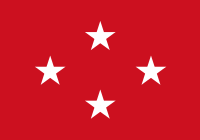
Marine Corps four-star general
This is a complete list of four-star generals in the United States Marine Corps. The rank of general (or full general, or four-star general) is the highest rank in the Marine Corps. It ranks above lieutenant general (three-star general).
There have been 69 four-star generals in the history of the United States Marine Corps. Of these, 51 achieved that rank while on active duty, 17 were promoted upon retirement in recognition of combat citations ("tombstone promotions", 1942-1959), and one was promoted posthumously. Generals entered the Marine Corps via several paths: 30 via Officer Candidates School (OCS), 21 via Naval Reserve Officer Training Corps (NROTC) at a civilian university, 10 via the United States Naval Academy (USNA), 4 via Reserve Officers' Training Corps (ROTC) at a civilian university, and 4 via ROTC at a senior military college.
List of generals
Entries in the following list of four-star generals are indexed by the numerical order in which each officer was promoted to that rank while on active duty, or by an asterisk (*) if the officer did not serve in that rank while on active duty. Each entry lists the general's name, date of rank,[1] active-duty positions held while serving at four-star rank,[2] number of years of active-duty service at four-star rank (Yrs),[3] year commissioned and source of commission,[4] number of years in commission when promoted to four-star rank (YC),[5] and other biographical notes.[6]
The list is sortable by last name, date of rank, number of years of active-duty service at four-star rank, year commissioned, and number of years in commission when promoted to four-star rank.
| # | Name | Photo | Date of rank[1] | Position | Yrs[3] | Commission[4] | YC[5] | Notes |
|---|---|---|---|---|---|---|---|---|
| 1 | Alexander A. Vandegrift |  |
21 Mar 1945 |
|
2 | 1909 (OCS) | 36 | (1887–1973) Awarded Medal of Honor, 1942. |
| * | Roy S. Geiger | 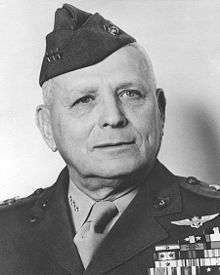 |
23 Jan 1947 |
|
0 | 1909 (OCS) | 38 | (1885–1947) [7] |
| 2 | Clifton B. Cates | 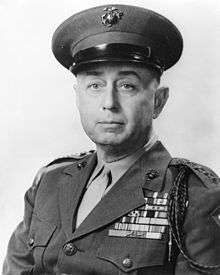 |
01 Jan 1948 |
|
4 | 1917 (OCS) | 31 | (1893–1970) [8] |
| 3 | Lemuel C. Shepherd, Jr. | 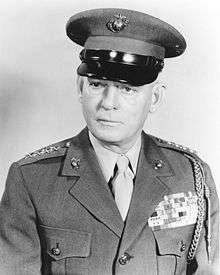 |
01 Jan 1952 |
|
7 | 1917 (VMI) | 35 | (1896–1990) [9] |
| 4 | Randolph M. Pate | 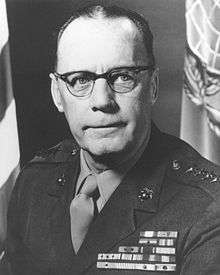 |
01 Jan 1956 |
|
4 | 1921 (VMI) | 35 | (1898–1961) |
| 5 | David M. Shoup | 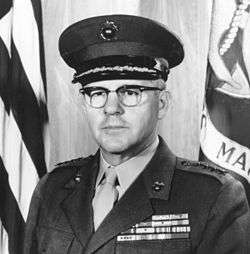 |
01 Jan 1960 |
|
4 | 1926 (ROTC) | 34 | (1904–1983) Awarded Medal of Honor, 1943. |
| 6 | Wallace M. Greene Jr. |  |
01 Jan 1964 |
|
4 | 1930 (USNA) | 34 | (1907–2003) |
| 7 | Leonard F. Chapman, Jr. | 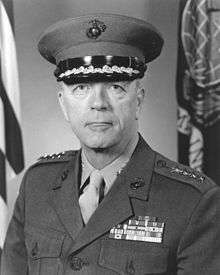 |
01 Jan 1968 |
|
4 | 1935 (NROTC) | 33 | (1913–2000) U.S. Commissioner of Immigration and Naturalization, 1973–1977. |
| 8 | Lewis W. Walt | 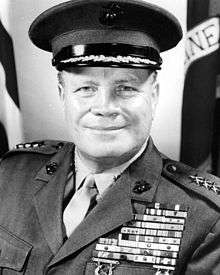 |
02 Jun 1969 |
|
2 | 1936 (ROTC) | 33 | (1913–1989) |
| 9 | Raymond G. Davis |  |
12 Mar 1971 |
|
1 | 1938 (ROTC) | 33 | (1915–2003) Awarded Medal of Honor, 1950. |
| 10 | Keith B. McCutcheon | 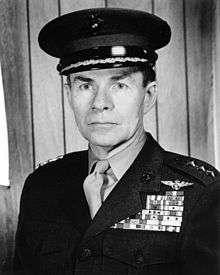 |
01 Jul 1971 |
|
0 | 1937 (ROTC) | 34 | (1915–1971) [10] |
| 11 | Robert E. Cushman Jr. |  |
01 Jan 1972 |
|
4 | 1935 (USNA) | 37 | (1914–1985) Deputy Director of Central Intelligence, 1969–1971. |
| 12 | Earl E. Anderson | 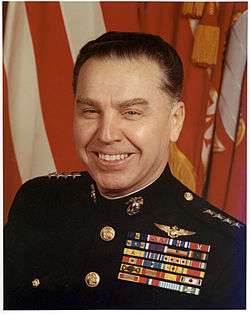 |
31 Mar 1972 |
|
3 | 1940 (NROTC) | 32 | (1919–2015) |
| 13 | Louis H. Wilson Jr. |  |
01 Jul 1975 |
|
4 | 1941 (OCS) | 34 | (1920–2005) Awarded Medal of Honor, 1944. |
| 14 | Samuel Jaskilka | 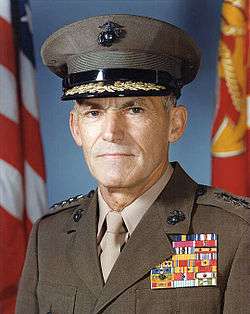 |
04 Mar 1976 |
|
3 | 1942 (OCS) | 34 | (1919–2012) |
| 15 | Robert H. Barrow | |
01 Jul 1978 |
|
5 | 1942 (OCS) | 36 | (1922–2008) |
| 16 | Kenneth McLennan |  |
02 Jul 1979 |
|
3 | 1945 (OCS) | 34 | (1925–2005) |
| 17 | Paul X. Kelley |  |
01 Jul 1981 |
|
6 | 1950 (NROTC) | 31 | (1928– ) |
| 18 | John K. Davis |  |
01 Jul 1983 |
|
3 | 1950 (NROTC) | 33 | (1927– ) |
| 19 | George B. Crist | |
22 Nov 1985 |
|
3 | 1952 (NROTC) | 33 | (1931– ) |
| 20 | Thomas R. Morgan | 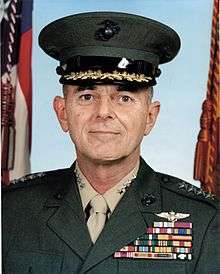 |
01 Jun 1986 |
|
2 | 1952 (NROTC) | 34 | (1930– ) |
| 21 | Alfred M. Gray Jr. | 01 Jul 1987 |
|
4 | 1952 (OCS) | 35 | (1928– ) | |
| 22 | Joseph J. Went |  |
01 Jul 1988 |
|
2 | 1952 (NROTC) | 36 | (1930– ) |
| 23 | John R. Dailey | 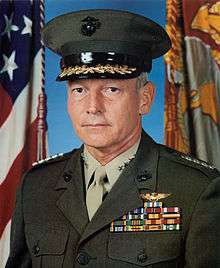 |
01 Aug 1990 |
|
3 | 1956 (NROTC) | 34 | (1934– ) Associate Deputy Administrator, National Aeronautics and Space Administration, 1992–1999; Director, National Air and Space Museum, 2000–present. |
| 24 | Carl E. Mundy, Jr. | |
01 Jul 1991 |
|
4 | 1957 (NROTC) | 34 | (1935–2014) President, United Service Organizations, 1996–2000. |
| 25 | Joseph P. Hoar |  |
01 Sep 1991 |
|
3 | 1957 (NROTC) | 34 | (1934– ) |
| 26 | Walter E. Boomer | 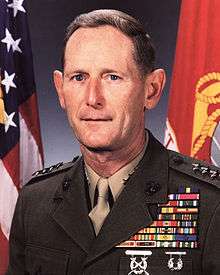 |
01 Sep 1992 |
|
2 | 1960 (NROTC) | 32 | (1938– ) |
| 27 | Richard D. Hearney |  |
15 Jul 1994 |
|
2 | 1962 (OCS) | 32 | (1939– ) |
| 28 | John J. Sheehan |  |
1994 |
|
3 | 1962 (NROTC) | 32 | (1940– ) |
| 29 | Charles C. Krulak | 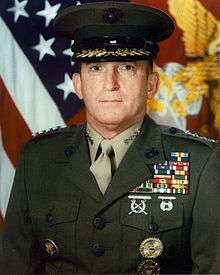 |
29 Jun 1995 |
|
4 | 1964 (USNA) | 31 | (1942– ) |
| 30 | Richard I. Neal | 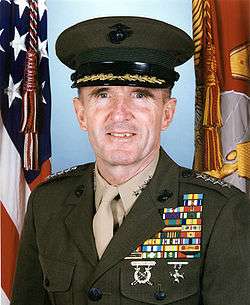 |
19 Sep 1996 |
|
2 | 1965 (NROTC) | 31 | (1942– ) |
| 31 | Anthony C. Zinni | 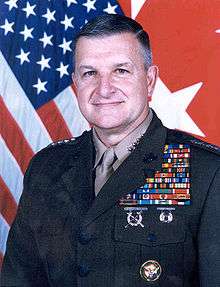 |
08 Aug 1997 |
|
3 | 1965 (NROTC) | 32 | (1943– ) U.S. Special Envoy to the Middle East, 2002–2003. |
| 32 | Charles E. Wilhelm | 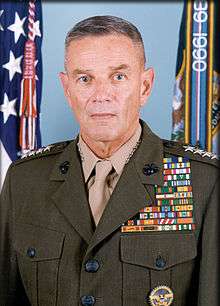 |
25 Sep 1997 |
|
3 | 1964 (NROTC) | 33 | (1941– ) |
| 33 | Terrence R. Dake |  |
05 Sep 1998 |
|
2 | 1966 (OCS) | 32 | (1944– ) |
| 34 | James L. Jones |  |
30 Jun 1999 |
|
7 | 1967 (NROTC) | 32 | (1943– ) National Security Advisor, 2009–2010. |
| 35 | Peter Pace |  |
08 Sep 2000 |
|
7 | 1967 (USNA) | 33 | (1945– ) Awarded Presidential Medal of Freedom, 2008. |
| 36 | Carlton W. Fulford, Jr. |  |
01 Oct 2000 |
|
2 | 1966 (USNA) | 34 | (1944– ) |
| 37 | Michael J. Williams | 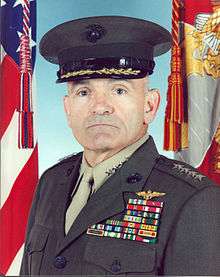 |
01 Nov 2000 |
|
2 | 1967 (USNA) | 33 | (1943– ) |
| 38 | William L. Nyland | 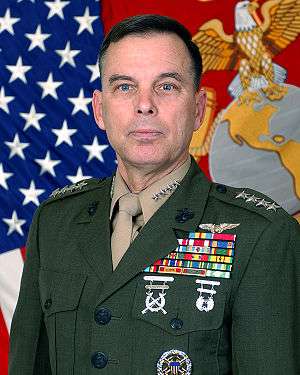 |
04 Sep 2002 |
|
3 | 1968 (NROTC) | 34 | (1946– ) |
| 39 | Michael W. Hagee | 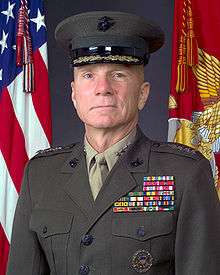 |
14 Jan 2003 |
|
3 | 1968 (USNA) | 35 | (1944– ) |
| 40 | James E. Cartwright | 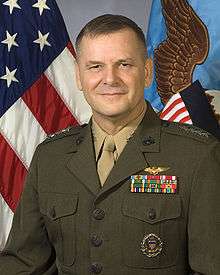 |
01 Sep 2004 |
|
7 | 1971 (NROTC) | 33 | (1949– ) |
| 41 | Robert Magnus |  |
01 Nov 2005 |
|
3 | 1969 (NROTC) | 36 | (1947– ) |
| 42 | James T. Conway | 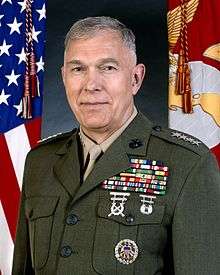 |
13 Nov 2006 |
|
4 | 1970 (OCS) | 36 | (1947– ) |
| 43 | James N. Mattis |  |
09 Nov 2007 |
|
6 | 1972 (OCS) | 35 | (1950– ) |
| 44 | James F. Amos |  |
02 Jul 2008 |
|
6 | 1970 (NROTC) | 38 | (1946– ) First naval aviator to become commandant. |
| 45 | Joseph F. Dunford, Jr. | |
23 Oct 2010 |
|
6 | 1977 (OCS) | 33 | (1955– ) |
| 46 | John R. Allen |  |
18 Jul 2011 |
|
2 | 1976 (USNA) | 35 | (1954– ) |
| 47 | John F. Kelly |  |
19 Nov 2012 |
|
3 | 1976 (OCS) | 36 | (1950– ) |
| 48 | John M. Paxton, Jr. |  |
15 Dec 2012 |
|
4 | 1974 (OCS) | 38 | (1951– ) |
| 49 | Robert B. Neller | 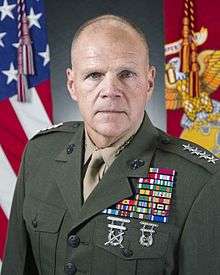 |
24 Sep 2015 |
|
1 | 1975 (OCS) | 40 | (1953– ) |
| 50 | Thomas D. Waldhauser | 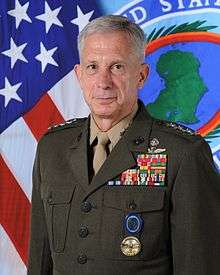 |
18 Jul 2016 |
|
0 | 1976 (OCS) | 40 | (1953– ) |
| 51 | Glenn M. Walters |  |
02 Aug 2016 |
|
0 | 1979 (NROTC) | 37 | (1957– ) |
Tombstone generals
The Act of Congress of March 4, 1925, allowed officers in the Navy, Marine Corps, and Coast Guard to be promoted one grade upon retirement if they had been specially commended for performance of duty in actual combat. Combat citation promotions were colloquially known as "tombstone promotions" because they conferred all the perks and prestige of the higher rank including the loftier title on their tombstones but no additional retirement pay. The Act of Congress of February 23, 1942, enabled tombstone promotions to three- and four-star grades. Tombstone promotions were subsequently restricted to citations issued before January 1, 1947, and finally eliminated altogether effective November 1, 1959. The practice was terminated in an effort to encourage senior officer retirements prior to the effective date of the change to relieve an overstrength in the senior ranks.
Any general who actually served in a grade while on active duty receives precedence on the retirement list over any tombstone general holding the same retired grade. Tombstone generals rank among each other according to the dates of their highest active duty grade.
The following list of tombstone generals is sortable by last name, date of rank as lieutenant general, date retired, and year commissioned.
| Name | Date of rank (LGEN) | Date retired | Commission [4] | Notes | |
|---|---|---|---|---|---|
| 1 | Thomas Holcomb | 20 Jan 1942 | Jan 1944 | 1900 (OCS) | (1879–1965) U.S. Minister to South Africa, 1944–1948. |
| 2 | Holland M. Smith | 28 Feb 1944 | May 1946 | 1905 (OCS) | (1882–1967) |
| 3 | Harry Schmidt | 01 Mar 1946 | Jul 1948 | 1909 (OCS) | (1886–1968) |
| 4 | Allen H. Turnage | 04 Oct 1946 | Jan 1948 | 1913 (OCS) | (1891–1971) |
| 5 | LeRoy P. Hunt | 01 Jul 1949 | Jul 1951 | 1917 (OCS) | (1892–1968) |
| 6 | Franklin A. Hart | 22 Feb 1951 | Aug 1952 | 1917 (OCS) | (1894–1967) |
| 7 | Graves B. Erskine | 02 Jul 1951 | Jul 1953 | 1917 (OCS) | (1897–1973) Assistant to the Secretary of Defense for Special Operations, 1953–1961. |
| 8 | Gerald C. Thomas | 08 Mar 1952 | Jan 1956 | 1917 (OCS) | (1894–1984) |
| 9 | Oliver P. Smith | 23 Jul 1953 | Sep 1955 | 1917 (OCS) | (1893–1977) |
| 10 | William O. Brice | 28 Aug 1953 | 1956 | 1921 (Citadel) | (1898–1972) |
| 11 | Christian F. Schilt | 01 Aug 1955 | Apr 1957 | 1919 (OCS) | (1895–1987) Awarded Medal of Honor, 1928. |
| 12 | Alfred H. Noble | 01 Aug 1955 | Nov 1956 | 1917 (OCS) | (1894–1983) |
| 13 | Vernon E. Megee | 01 Jan 1956 | Nov 1959 | 1922 (OCS) | (1900–1992) |
| 14 | Edwin A. Pollock | 01 Jan 1956 | Nov 1959 | 1921 (Citadel) | (1899–1982) |
| 15 | Merrill B. Twining | 12 Sep 1956 | Oct 1959 | 1923 (USNA) | (1902–1996) Brother of Air Force General Nathan F. Twining. |
| 16 | Ray A. Robinson | 01 Nov 1956 | Nov 1957 | 1917 (OCS) | (1896–1976) |
| 17 | Robert E. Hogaboom | 01 Dec 1957 | Oct 1959 | 1925 (USNA) | (1902–1993) |
Timeline
By the Act of March 21, 1945, Congress permitted the President to appoint the Commandant of the Marine Corps to the grade of general. Alexander Vandegrift, then Commandant, was promoted from lieutenant general to general on April 4, 1945, to rank from March 21 of that year. He thus became the first Marine to serve in the grade of general. The Office of the Commandant was permanently fixed at the grade of four-star general under authority of the Act of August 7, 1947. All Commandants since that date have been entitled by law to serve in the grade of general and, in accordance with the provisions of 10 U.S.C. § 5201, to retire in that grade.
In April 1969, the Senate passed and sent a bill to the White House that makes the Assistant Commandant of the Marine Corps a four-star general when the active duty strength of the Marine Corps exceeds 200,000. On May 5, 1969, President Richard Nixon signed the bill, and Lieutenant General Lewis William Walt was promoted to that rank on June 2, 1969, thus becoming the first Assistant Commandant of the Marine Corps to attain four-star rank. Legislation allowing the Assistant Commandant to wear the four-star insignia regardless of the strength of the Marine Corps was approved by President Gerald Ford on March 4, 1976.
On November 22, 1985, General George B. Crist was promoted to four-star rank and on November 27, he assumed the position of Commander in Chief of U.S. Central Command at MacDill Air Force Base, Florida. His appointment marked the first time a Marine headed a unified command and the first time the Corps had three four-star generals on active duty at the same time. Since 1985, a number of Marines have served in joint positions holding four-star rank, and it is no longer uncommon for the Corps to have four or five four-star generals on active duty at the same time.
In 2005, General Peter Pace became the first Marine to be appointed as Chairman of the Joint Chiefs of Staff, the chief military advisor to the President of the United States and most senior appointment in the United States armed forces. Previously, in 2001, General Pace was the first Marine officer to be appointed as Vice Chairman of the Joint Chiefs of Staff (VCJCS).
The standard tour length for the commandant (CMC) is four years; two years for the assistant commandant (ACMC); for a combatant commander, three years; and a total of four years served in consecutive two-year terms for the chairman and vice chairman of the Joint Chiefs of Staff (CJCS/VCJCS).

See also
| Wikimedia Commons has media related to Generals of the United States Marine Corps. |
- General (United States)
- List of active duty United States four-star officers
- List of United States Air Force four-star generals
- List of United States Army four-star generals
- List of United States Coast Guard four-star admirals
- List of United States Navy four-star admirals
- List of United States Public Health Service Commissioned Corps four-star admirals
- List of United States military leaders by rank
Notes
- 1 2 Dates of rank are taken, where available, from the U.S. Navy and Marine Corps register of active and retired commissioned officers, or from the World Almanac and Book of Facts.
- ↑ Positions listed are those held by the officer when promoted to general. Dates listed are for the officer's full tenure, which may predate promotion to four-star rank or postdate retirement from active duty.
- 1 2 The number of years of active-duty service at four-star rank is approximated by subtracting the year in the "Date of rank" column from the last year in the "Position" column.
- 1 2 3 Sources of commission are listed in parentheses after the year of commission and include: the Officer Candidates School (OCS); the United States Naval Academy (USNA); Naval Reserve Officer Training Corps (NROTC) at a civilian university; Reserve Officers' Training Corps (ROTC) at a civilian university; and ROTC at a senior military college such as the Virginia Military Institute (VMI) or The Citadel (Citadel).
- 1 2 The number of years in commission before being promoted to four-star rank is approximated by subtracting the year in the "Commission" column from the year in the "Date of rank" column.
- ↑ Notes include years of birth and death; awards of the Medal of Honor, Congressional Gold Medal, Presidential Medal of Freedom, or honors of similar significance; major government appointments; university presidencies or equivalents; familial relationships with other four-star officers or significant government officials such as U.S. Presidents, cabinet secretaries, U.S. Senators, or state governors; and unusual career events such as premature relief or death in office.
- ↑ Posthumously promoted to general by Act of Congress, Jun 1947, with date of rank 23 Jan 1947.
- ↑ Reverted to lieutenant general, Jan 1952; retired as general, Jun 1954.
- ↑ Retired as general, Jan 1956; recalled as general, Mar 1956.
- ↑ Unable to assume post due to ill health; promoted and placed on retired list as general by Act of Congress, 01 Jul 1971; died 13 Jul 1971.
References
![]() This article incorporates public domain material from websites or documents of the United States Marine Corps.
This article incorporates public domain material from websites or documents of the United States Marine Corps.
- United States Marine Corps History Division, Who's Who in Marine Corps History
- History Division, Four-Star Generals of the Marine Corps
- History Division, Commandants of the U.S. Marine Corps
- History Division, Marine Corps Assistant Commandants
- United States Marine Corps Manpower & Reserve Affairs, Biographies: General Officers & Senior Executives
- United States Marine Corps Officer Candidates School, History of Officer Candidates School
- U.S. Bureau of Naval Personnel (1950–1959), Register of Commissioned and Warrant Officers of the United States Navy and Marine Corps, Washington D.C.: Department of the Navy
- "Generals' Exodus", TIME Magazine, September 7, 1959
